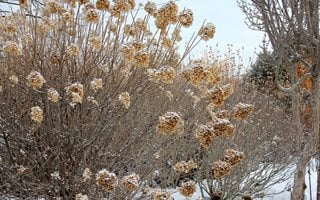How To Protect & Care for Your Hydrangeas in Winter
Properly caring for your hydrangea in winter will ensure beautiful flowers in spring and summer
Incrediball® smooth hydrangea fairs well in snow and other winter weather without protection. Photo by: Proven Winners.
Though most hydrangeas are durable plants that don’t require an excessive amount of special attention to flourish, some do need to be prepped to withstand the cold winter months. Below are tips for protecting your hydrangeas so they survive cold winters and continue producing those colorful balls of flowers when spring and summer come around.
Does Your Hydrangea Need Special Winter Care?
Not all hydrangeas necessarily need protection from winter weather. Determining whether they need protection depends on the type of hydrangeas you have and what winters are like where you live.
What types of hydrangeas do you have?
Identify the types of hydrangeas you have in your garden to determine whether they need winter protection.
Need help identifying your hydrangea? See our article on hydrangea types.
Hydrangeas that almost always need winter protection:
- Hydrangea macrophylla (bigleaf), hardy down to Zone 5.
- Hydrangea serrata (mountain), hardy down to Zone 6.
Bigleaf and mountain hydrangeas bloom on old wood, which means that their buds form on existing stems before winter comes. Those new buds need to be protected in areas that experience freezing winter temperatures so they can bloom when summer arrives.
Even if you live in a mild climate, you should still protect these hydrangeas on days or nights that you expect temperatures to dip below the freezing point.
Hydrangeas that sometimes need winter protection:
- Hydrangea quercifolia (oakleaf), hardy down to Zone 5
- Hydrangea anomala ssp. petiolaris (climbing), hardy down to Zone 4
Oakleaf and climbing hydrangeas also bloom on old wood, but they tend to be slightly more hardy than bigleaf or mountain hydrangeas. Though they tend to fare well in cold weather, it’s best to practice caution and protect them if you expect freezing winter temperatures.

Panicle hydrangeas don't typically need winter protection to bloom prolifically. Shown here: ‘Limelight’ Hydrangea paniculata. Photo by: Proven Winners.
Hydrangeas that rarely need protection:
- Hydrangea arborescens (Smooth), hardy down to Zone 3
- Hydrangea paniculata (Panicle), hardy down to Zone 3
Smooth and panicle hydrangeas both bloom on new growth and are both hardy all the way down to Zone 3, so they fare well in cold winter temperatures. If you live in a climate with freezing winters, you may as well play it safe and protect your smooth or panicle hydrangeas.
What are winters like in your location?
If you live in a location where winter temperatures are frequently below freezing, you need to protect your hydrangeas—sometimes even those that bloom on new growth. An especially brutal winter can take a toll on your plants, and it’s best not to risk it.
If you’re in a location with mild winters but you still experience some nights and/or early mornings that reach freezing temperatures, cover the base of the plant with mulch before the freezing occurs.
Is your hydrangea in a container?
If you grow your hydrangeas in pots, winterizing them is simple. You may be tempted to store them in your garage, basement, or enclosed patio, but overwintering them indoors may disrupt their natural rhythm. Instead, move them to a spot next to your home where they won’t be blasted by harsh wind or heavy snow, add a layer of mulch and monitor moisture levels throughout the winter. Those that are susceptible to freezing temps will still need winter protection of branches, in fact even more so.
Hydrangea Winter Care Tips
If you’ve determined that your hydrangeas need to be winterized, here are steps you can take to protect them so they can bloom beautifully the following spring.
Insulate
Proper insulation will protect your outdoor hydrangeas from intense cold. Here are tips for insulation:
In this video, see how Susan Martin of Gardener Sue’s News, in Holland, Michigan, wraps her bigleaf hydrangeas in chicken wire and provides insulation for winter. Here's another video showing how Martin unwraps her hydrangeas.
- Mulch. At the bare minimum, add a layer of mulch around the base of your hydrangea plant. You can use natural materials such as bundles of straw, dried pinecones, and the like. For gardeners in mild climates that experience a few frosty days and/or nights here and there, mulching is an easy step you can take to protect your hydrangeas.
- Create a barrier between your plant and the elements. Creating a shield from the elements is intended for gardeners who experience very cold weather and a significant number of days and or nights with freezing temperatures. It’s not necessary for gardeners in mild climates to take this level of precaution. There are several ways to protect your hydrangeas from freezing temperatures:
- Keep your barrier in place all winter, only removing it once the threat of frost has passed completely.
- Place an A-frame structure over your plant to protect it from snow and insulate the base of the plant.
- Drape the plant with frost protection fabric to protect it from cold weather. See an example of an unframed drape and A-frame on horticulturist and garden writer Lorraine Ballato’s blog.
- Build a cage around your plant with chicken wire, fill it with mulch, and wrap it in burlap.
Water adequately
Properly hydrating a plant will help protect the cell walls from damage during freezing temperatures, so it’s important to not let your plant dry out.
If you live in an area that experiences snowfall during the winter, you probably won’t need to water your hydrangeas at all during winter. However, if you live in a dry, cold climate, you should water them once every couple of weeks or once a month to keep the soil from drying out.
If you do need to water, be intentional about when you’re watering. Give your plant enough time to soak up the moisture before the freezing temperatures hit again. Make sure it’s at least around 40 degrees outside when you water. (In other words, it’s not a good idea to water your hydrangea right before the sun goes down and it’s expected to freeze overnight.)
Should hydrangeas be pruned during winter?
No. Don’t prune your hydrangeas during winter. Doing so can stress the plant and interfere with its ability to bloom during the next growing season.
Do hydrangeas need to be fertilized during winter?
No, you do not need to give your hydrangea plants fertilizer over winter. Instead, they should be fertilized in spring and early summer. Learn more about fertilizing hydrangeas.








